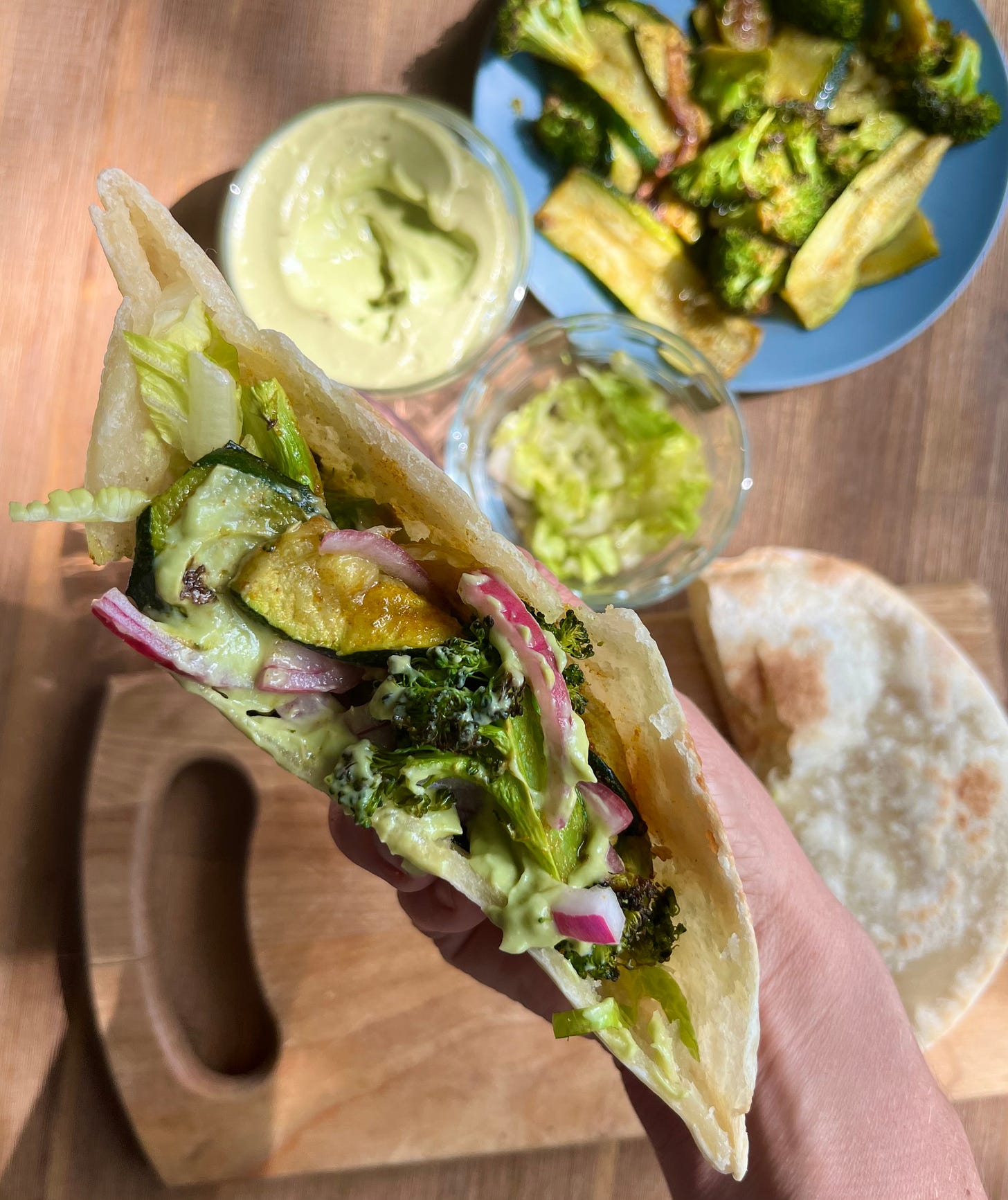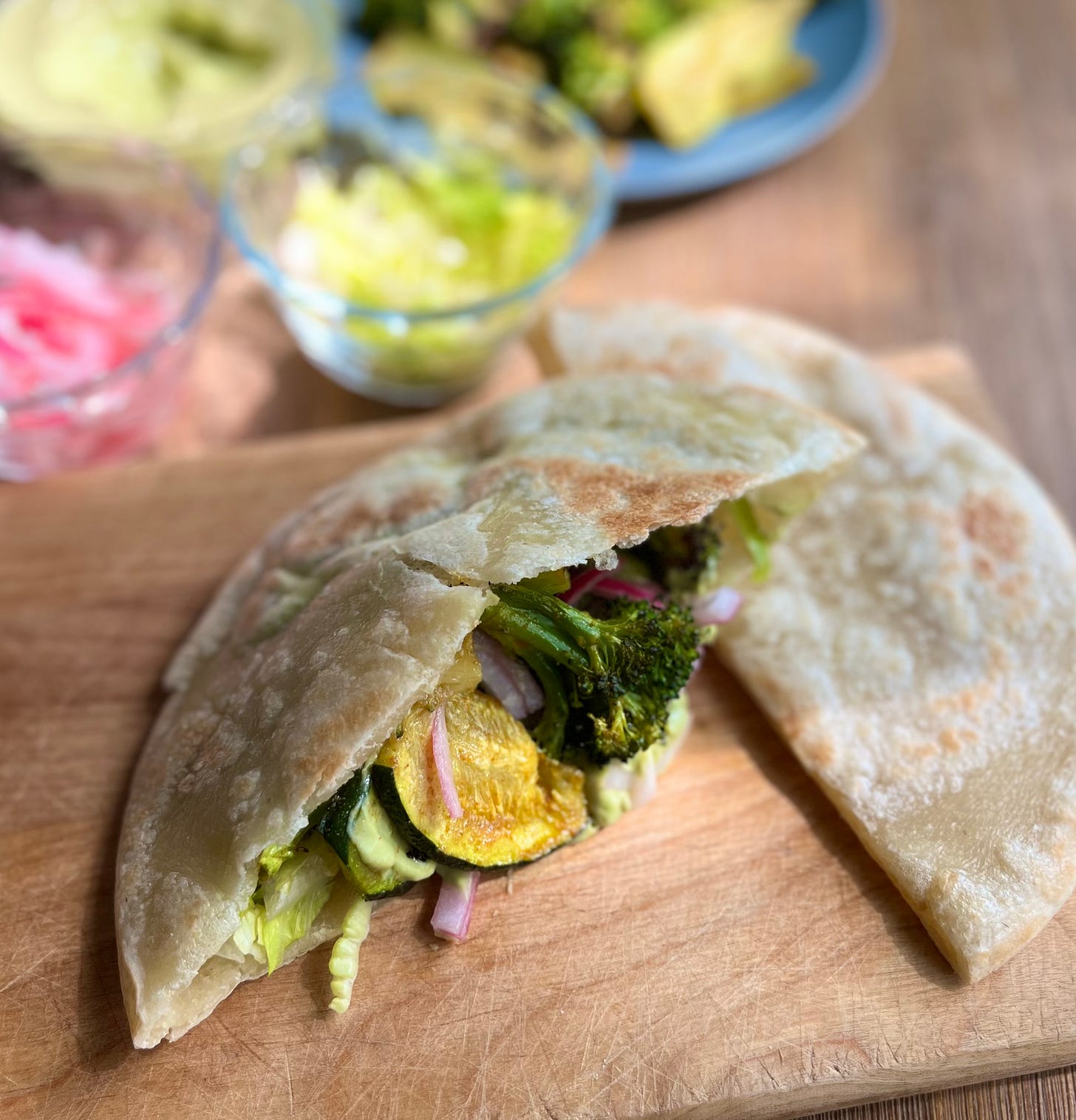Roasted Broccoli and Zucchini-Stuffed Pitas
A veggie-forward pita sandwich for everyone (even gluten free folks)
Hey there, If you’ve found your way here but are not yet subscribed for the weekly newsletter, you can do that here. You will never miss a recipe or a story, and I’ll be eternally grateful for your support.
Hello Dear Readers of The Jewish Table,
This week I want to begin with a request for all of us as a community.
Sometimes it feels impossible to find the voices urging for and insisting on peace in Israel and Gaza. Traditional media outlets, and especially social media algorithms, privilege the most “clickable” emotions: outrage, fear, disgust, hopelessness. So these are the emotions that typically get to lead the conversation.
But voices of peace and coexistence exist. Yes, in Israel. Yes, in Gaza. Yes, in America. And beyond. I know from our conversations here that many of us fall somewhere in the nuanced, empathetic middle, rather than on the more extreme fringes of one “side” or the other. But our voices do not always break through.
So here is my request/question: How can we, together, help to lift up voices of peace? How can we use our own influence—as insignificant as it might feel—to create a permission structure for others to expand their empathy? How might we help friends who feel silenced by the loudest and most extreme voices make their own voices heard? How might we amplify peace-focused thought leaders, so they reach wider audiences?
Uplifting voices of peace does not negate the absolute truths of devastation and hunger in Gaza. It does not negate the horror of settler-provoked violence against Palestinians in the West Bank. It does not negate the impossible agony Israeli communities feel waiting for the hostages to be returned home. And it does not negate the experiences of Jews around the world who have suffered under increased antisemitism.
What it *does* is remind us that the most extreme voices and the most corrupt/hateful “leaders” benefit from our ever-escalating fear and outrage—and that we don’t have to buy into their paradigm. Uplifting voices of peace also reminds us that our collective liberation is ultimately bound together.
I remain, as never, not an expert in Middle East politics. But I know that, collectively, we have more power than we believe we do. This week, I am asking you to consider one or two ways that you might help shift the conversation—on your group text threads, in your WhatsApp groups, on your social media accounts, and in your real life conversations—ever so slightly towards empathy, peace, and hope.
As I often do, I turn to Rabbi Sharon Brous (who deserves a much wider platform than she currently has) for Jewishly-rooted guidance, compassion, and nuance. She is the expert (and their are others—please share your favorites in the comments!) But we have the opportunity to make sure messages like hers break through the noise.
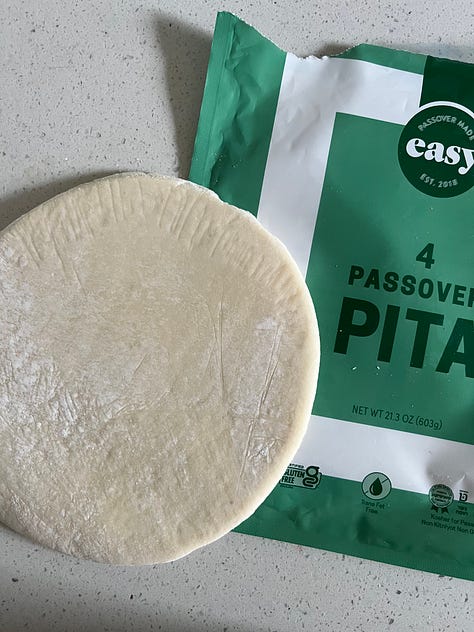
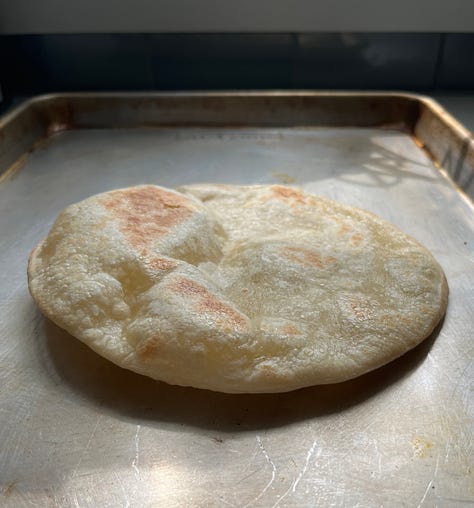
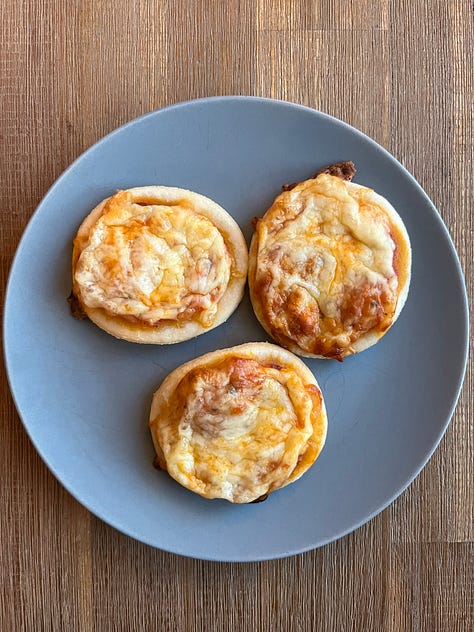
Gluten Free Easy
I am not gluten free and neither is anyone in my immediately family. But I’ve made a habit of keeping tabs on the ever-expanding world of gluten free products. You never know when a dinner guest will let you know they have Celiac disease or a gluten intolerance. Plus, I get to share the really good ones with you!
I first started noticing Gluten Free Easy on Instagram sometime during the last year. Then while shopping for Passover a couple weeks ago, I stumbled across their gluten free pizza dough in my supermarket’s freezer section. (The company makes both year-round kosher and Passover-certified products.) Since pizza is one of the few foods both my kids readily eat—but they are hit or miss on matzo pizza—I grabbed a package.
A few days later the company’s co-founder, Esther Anzaroot, offered to send me samples of their other products: gluten free puff pastry and gluten free pita rounds. It turns out she lives about a mile away from me in Brooklyn and literally drove them over. Gotta love small town, big city life. (For full transparency, this post is not sponsored beyond the samples.)
Anzaroot, who is a Syrian Jew, was first inspired to create gluten-free versions of her family’s traditional dishes to share with her son’s gluten-free girlfriend (now wife). After several years of making gluten free lahmajun, sambusak, and kibbeh at home and selling her products locally, she and a business partner founded Gluten Free Easy. Today, the company sells their doughs in over 100 kosher-friendly grocery stores around the country, and also ships nationally.
So nu, the verdict? I haven’t had the occasion to try the puff pastry yet, but the mini pizza dough rounds were lovely. They offered a sturdy but tender base for sauce and cheese and fully hit the spot for Passover lunch. Meanwhile, I was thrilled to watch the gluten free pita dough puff up handsomely in the oven, and even more excited to see that the halved pita split into perfect, stuffing-ready pockets. Texture-wise, it more closely resembled the doughy chew of laffa or naan, rather than the thin and crisp texture of a wheat flour-based pita. But laffa and naan are delicious, so no complaints from me!
Gluten Free Easy’s pita inspired this week’s recipe for Roasted Broccoli and Zucchini-Stuffed Pitas. (You can of course use regular pita instead of gluten free.) I adore the roasted cauliflower pita sandwiches made famous at Miznon. So I followed their lead and stuffed my pita with a veggie-forward mix of spiced roasted broccoli and zucchini, and paired it with pickled red onions, crunchy shredded lettuce, and generous dollops of avocado-tahini sauce.
It felt a little wild to tuck into a pita sandwich on Passover—but wild in an excellent way. I will definitely keep a package of Gluten Free Easy’s pita in my freezer year-round. If you are gluten free or have a gluten free family member, I would love to hear your thoughts if you try out their products.
Roasted Broccoli and Zucchini-Stuffed Pitas
Make this recipe yours by playing around with the toppings. Swap the quick pickled red onions with sliced cucumber pickles, pickled beets or turnips, giardiniera, or whatever you have in your fridge or pantry. Add a layer of hummus or labneh along with the avocado tahini sauce. Tuck some crumbled feta or goat cheese in along with the roasted vegetables. Add sprigs fresh cilantro, basil, or dill, or some chopped scallions. You get the idea.
Makes enough to fill for 4 pita halves (can easily be doubled)
Keep reading with a 7-day free trial
Subscribe to The Jewish Table to keep reading this post and get 7 days of free access to the full post archives.




